Snake season is upon us! As we inch closer to summer, the likelihood of seeing a snake increases exponentially. Thankfully, most of the snakes that we see in our yards are harmless. Still, there is the occasional scaly visitor that stops by to say hello that is less than friendly. There are four kinds of venomous snakes in Texas, and one of the most common is the copperhead. Today, we will be exploring Copperhead Snakes in Texas in terms of appearance and habitat. By the end, you should be able to identify if that snake you just saw was indeed a copperhead or something harmless!
Let’s get started.
Do Copperheads live in Texas?
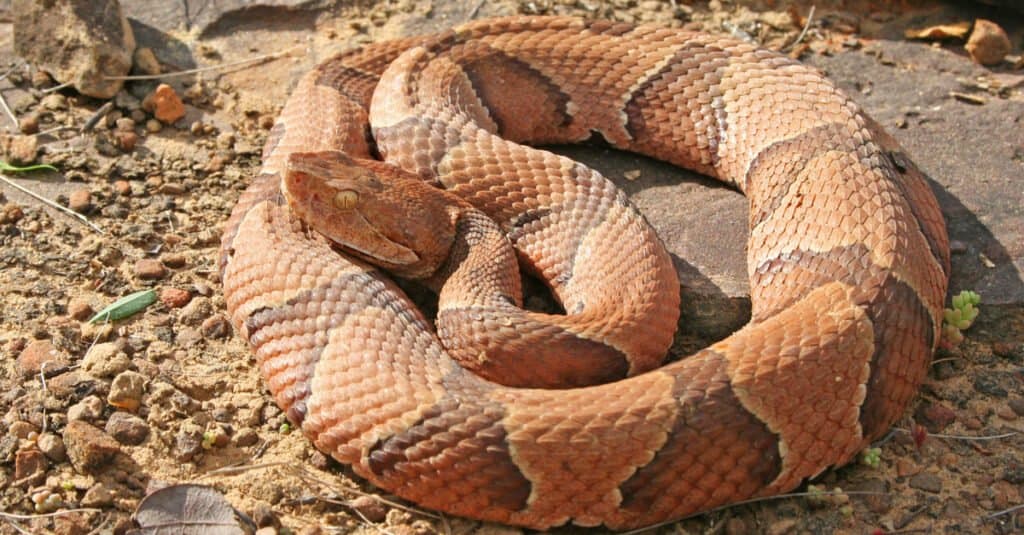
There are three subspecies of copperhead in Texas.
©Creeping Things/Shutterstock.com
Yes, there are three subspecies of copperhead in Texas, all of which are venomous.
Copperheads belong to a group of snakes known as “pit vipers” that get their name from the heat-sensing pits between their eyes and nose on both sides of their heads. Texas has three species of pit viper, the copperhead, cottonmouth, and rattlesnake. The fourth venomous species of snake is a coral snake, but it is less common and belongs to the cobra family.
This guide will help you identify a copperhead and the subspecies it belongs to in case you stumble upon it in your yard!
Identifying the 3 subspecies of Copperheads in Texas
There are three subspecies of copperhead in Texas, but all belong to the same species, Agkistrodon contortrix. While these snakes are remarkably beautiful, they are all equally dangerous and deserve the respect that any dangerous animal warrants. Let’s examine below.
Southern Copperhead: Appearance and Habitat
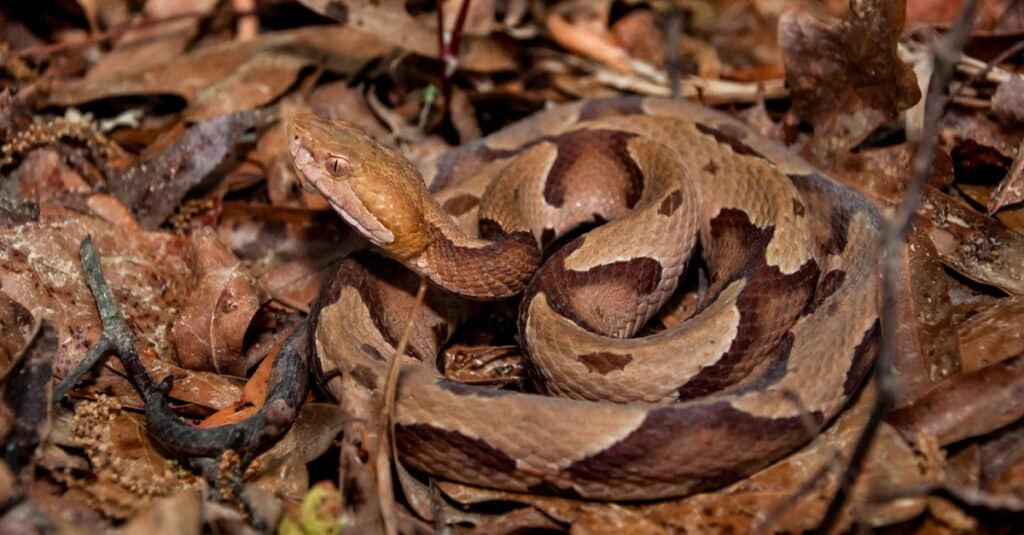
The southern copperhead has clear hourglass patterns that are thin near the spine.
©Jay Ondreicka/Shutterstock.com
Southern copperheads are characterized by their light tan body that often has a slight pinkish undertone. Their bodies are covered in rough (keeled) scales and have a characteristic hourglass pattern spreading down the back. The middle of the hourglass shapes usually rests along the spine, with the wider ends resting on either side of the snake towards the belly. Their eyes are yellow and appear feline. They always have discernable “pits” that rest between their nose and eyes on both sides of their heads. Adults usually reach 20-30 inches long and are somewhat stockier than other harmless snakes.
Southern copperheads live in the eastern third of Texas and are generally found near pastures, woodlands, and a source of water.
Broadbanded Copperhead: Appearance and Habitat
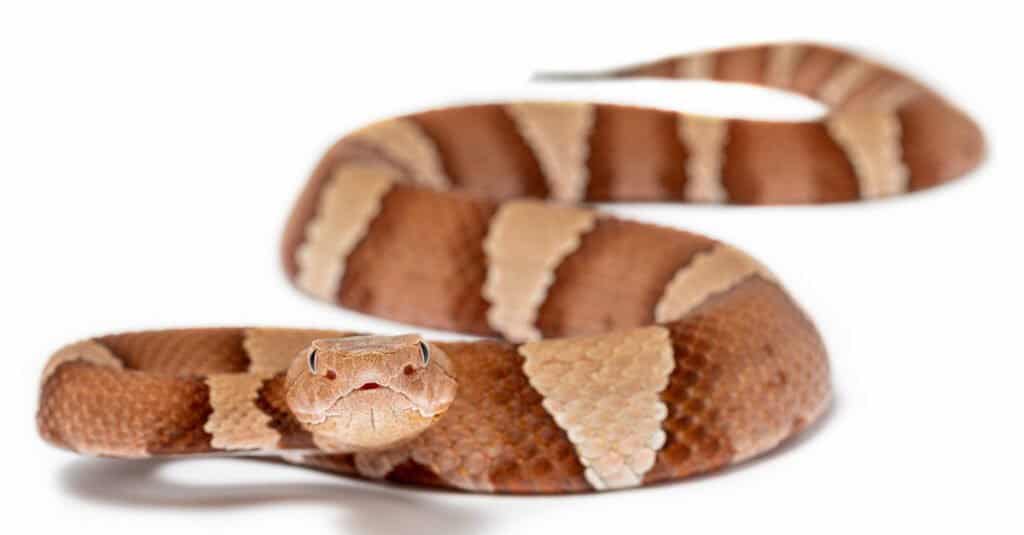
The broadbanded copperhead has clear, thick bands across a light tan body.
©Scott Delony/Shutterstock.com
Pronounstra Their bodies are covered in keeled scales but don’t have the clear hourglass shape that copperheads are known for. Instead, these individuals have a thick band that doesn’t narrow as it reaches the spine. They have the characteristic yellow eyes and pits that all copperheads do, making the banding the easiest way to distinguish these subspecies. Adults usually reach 2 feet in length.
Broadbanded copperheads live throughout central and western Texas and prefer lightly wooded areas not far from water.
Trans-Pecos Copperhead: Appearance and Habitat
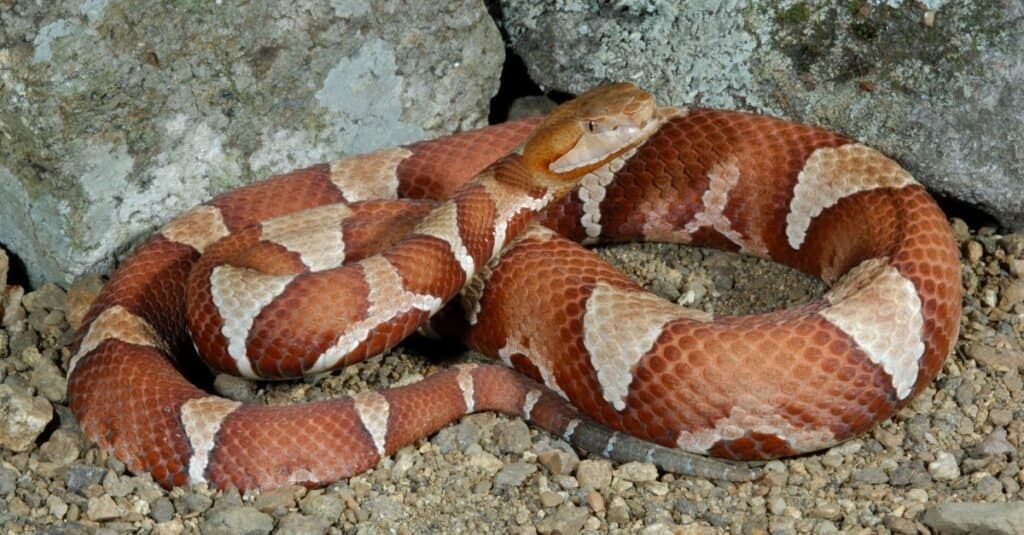
The Trans-Pecos copperhead has a reddish undertone and a colored tail as a juvenile.
©Breck P. Kent/Shutterstock.com
The Trans-Pecos copperhead is characterized by its light tan body and colorations that can be red-brown or gray-brown. It is incredibly similar to the broadbanded copperhead, with the primary difference being its belly. Trans-Pecos copperheads usually have an irregularly patterned underside with black and white designs, while the broadbanded copperhead has a minimally patterned white belly. Broadbanded and Trans-Pecos copperheads often interbreed, making identification even tougher. Adults usually reach 20-30 inches in length.
Trans-Pecos copperheads live near springs near the southern part of the Trans-Pecos region in the western part of Texas.
Snakes Commonly Mistaken For Copperheads in Texas
There are many snakes in Texas, some of which can look a bit like copperheads. Here is a list of some of the potential lookalikes, plus a quick way to identify them.
Rattlesnakes (Venomous)
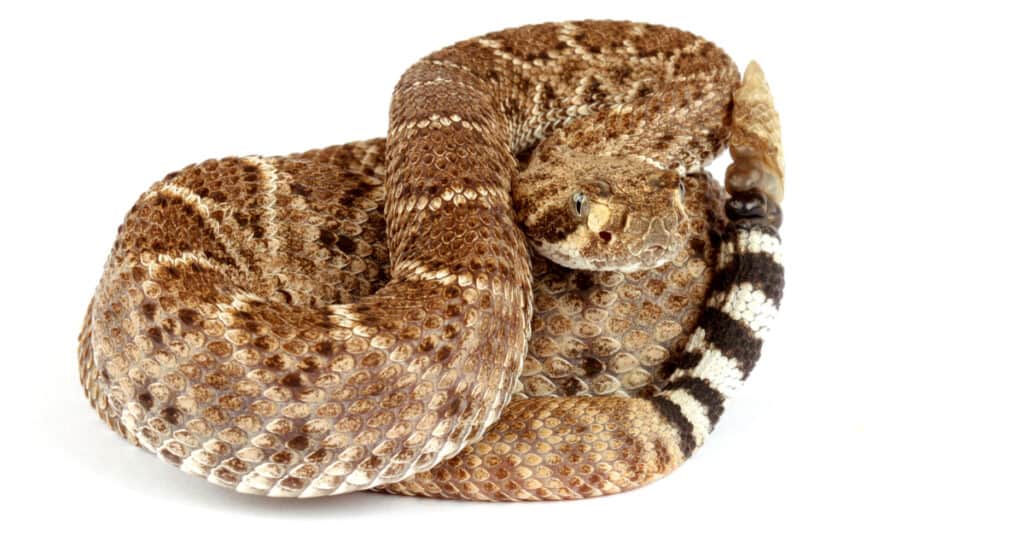
Rattlesnakes
have a distinct rattle at the end of their tail.
©Audrey Snider-Bell/Shutterstock.com
There are a few species of rattlesnake in Texas, all with their patterning and colors. The best way to tell the difference between a rattlesnake and a copperhead is by their rattle. Rattlesnakes have rattles on the ends of their tails, while copperheads do not.
Bull snakes (Non-venomous)
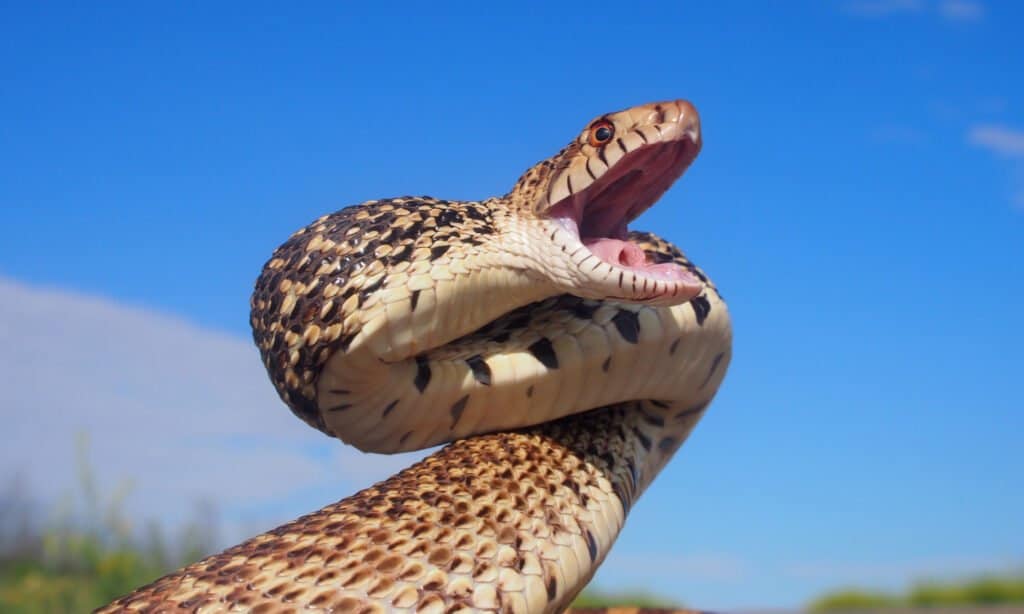
Bull snakes don’t have a rattle and have rectangular heads with round pupils.
©Markparker1983/Shutterstock.com
Many bull snakes resemble rattlesnakes and can have a similar body type to copperheads. Their main defense mechanism is actually looking like a rattlesnake as they can flare out their heads to make them look more triangular. The best way to differentiate the two is through the patterning (hourglass or banding on the copperheads) and the lack of pits on the bull snake.
Water snakes (Non-venomous)
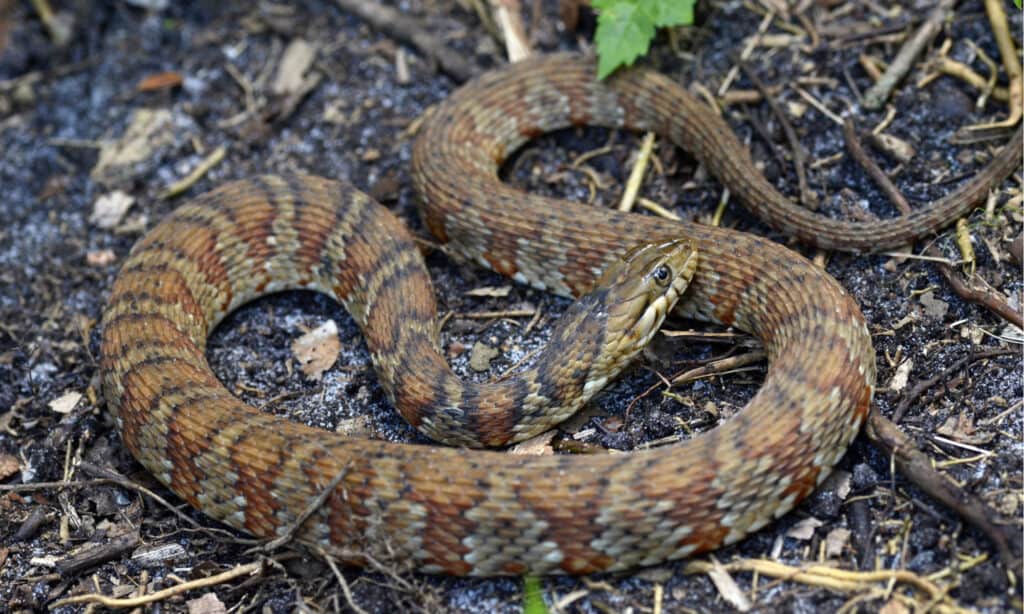
Watersnakes have black stripes on their jaw and round eyes.
©Patrick K. Campbell/Shutterstock.com
Water snakes resemble cottonmouths (water moccasins) more than copperheads, but their body shape can be similar. The best way to tell the difference is through their round eyes (copperheads have feline eyes) and clear black stripes on their jaws.
What Other States Do Copperheads Live In?
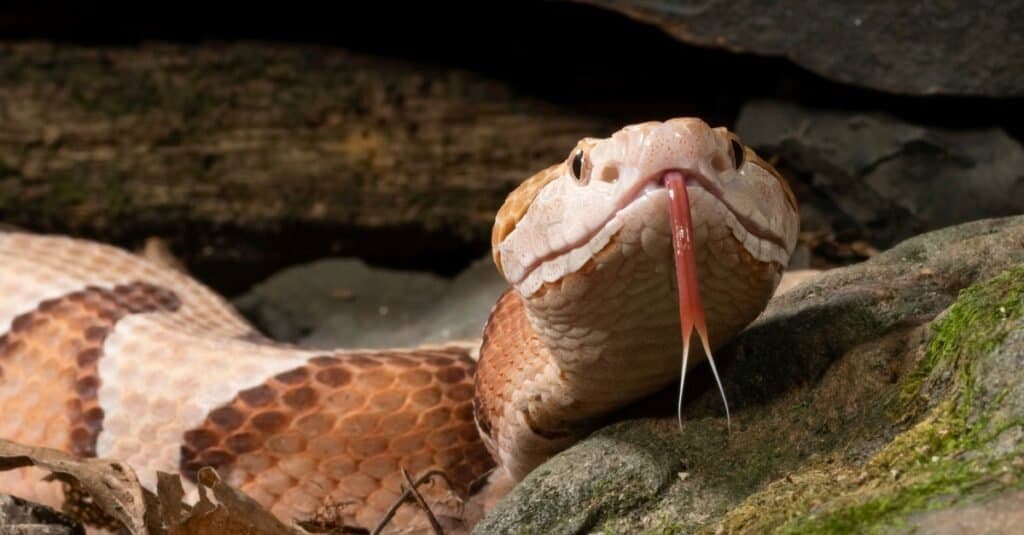
Copperheads live in the South, the Midwest as well as several other locations
©Joe McDonald/Shutterstock.com
Copperheads can be found in the following southern states: Alabama, Arkansas, the Carolinas, Delaware, Florida, Georgia, Kentucky, Louisiana, Maryland, Mississippi, Oklahoma, Tennessee, Texas, Virginia, and West Virginia.
They can also be found in the Midwest: Illinois, Indiana, Iowa, Kansas, Missouri, and Ohio.
Copperheads can also be found in: Connecticut, Massachusetts, Nebraska, New Jersey, New York, and Pennsylvania.
What Other Dangerous Animals Live in Texas?
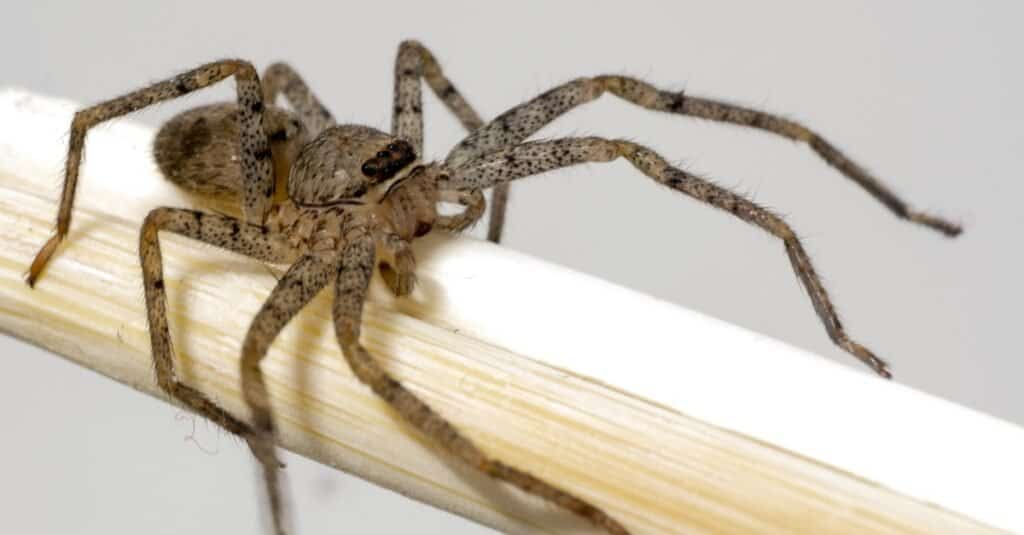
Brown recluse bites are not felt by their victims immediately
©Physics_joe/Shutterstock.com
- The Brown Recluse: Also known as the fiddleback spider, this arachnid is one of North America’s most dangerous. Its victims do not feel its bite at once. However, its venom is capable of damaging blood vessels, nerves, and tissue. Brown recluse venom is actually considered to be more dangerous than a rattlesnake’s.
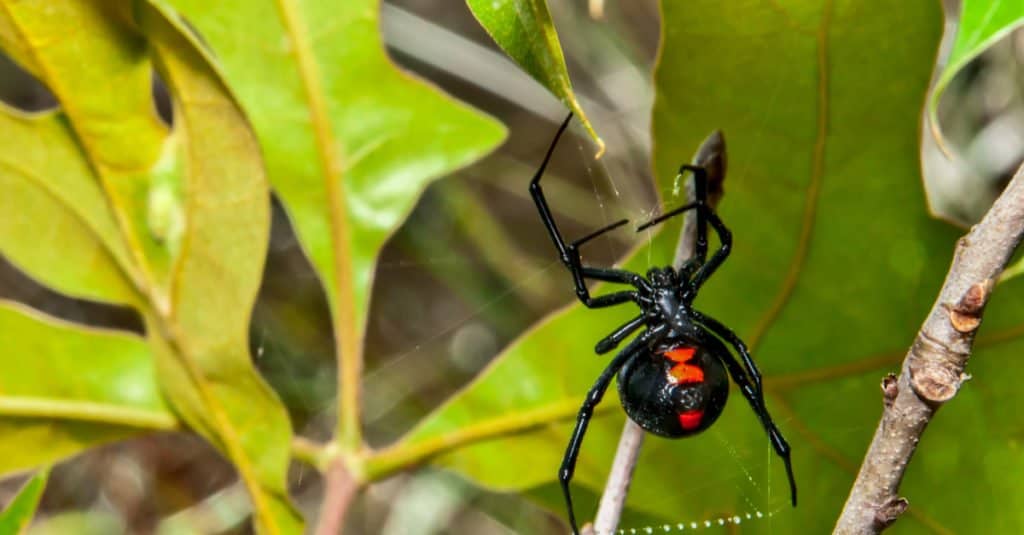
Black widow spider
venom is 15 times more potent than a prairie rattlesnake’s
©Jay Ondreicka/Shutterstock.com
- The Black Widow: Even more dangerous than the brown recluse, this arachnid is also known as Latrodectus mactans. The spider which can be recognized by its black color also has an hourglass pattern in red or yellow on the dorsal side of its abdomen. The female black widow produces its very own venom known as latrotoxin. It is a neurotoxin which is 15 times more potent than the prairie rattlesnake’s venom. Black widow venom causes symptoms such as sharp pain, nausea, perspiration, and an increased heart rate. Symptoms may persist for as long as three days and may even last up to seven days.
The photo featured at the top of this post is © Scott Delony/Shutterstock.com
Discover the "Monster" Snake 5X Bigger than an Anaconda
Every day A-Z Animals sends out some of the most incredible facts in the world from our free newsletter. Want to discover the 10 most beautiful snakes in the world, a "snake island" where you're never more than 3 feet from danger, or a "monster" snake 5X larger than an anaconda? Then sign up right now and you'll start receiving our daily newsletter absolutely free.
Thank you for reading! Have some feedback for us? Contact the AZ Animals editorial team.






